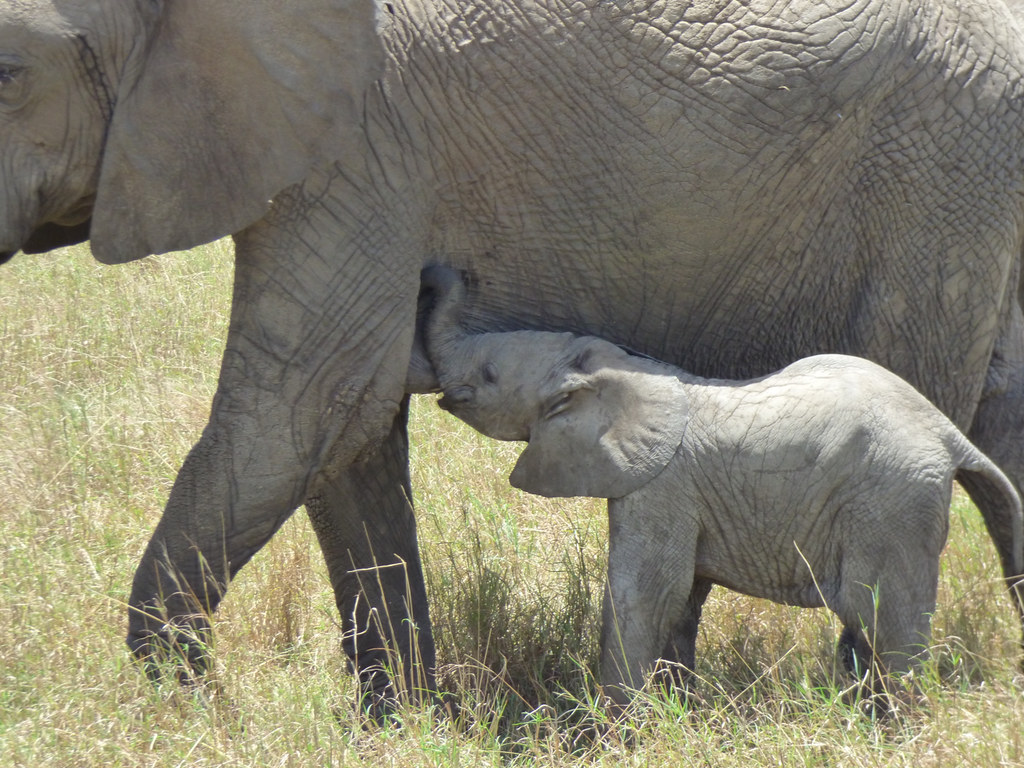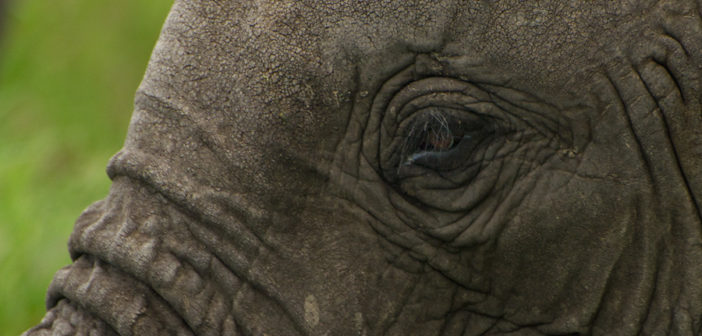Both anecdotal and scientific evidence has demonstrated repeatedly that animals from a wide range of species experience many of the same emotions we do. For those of us fighting for animal protection and liberation, this evidence is particularly important, as it serves as one of the most important reasons not to harm animals: because they have feelings. For many of us, wanting to reduce animal suffering is why we care about animal cruelty, and the idea that animals are essentially unfeeling, unthinking robots is foundational to allowing this cruelty to continue.
One of the animals most well-known to have a rich and complicated emotional life is the elephant. In the recently published anthology Thirty-Three Ways of Looking at an Elephant, authors explore who elephants are and what they mean to humans, throughout time and around the world. In the chapter “Triumph and Grief,” presented below, elephant researcher Joyce Poole uses her experience witnessing wild elephants after two births to demonstrate how she came to understand elephants’ capacity to feel grief and joy.
The following excerpt from Joyce Poole’s memoir Coming of Age with Elephants describes one the first close observations of a wild elephant giving birth: with the new mother, Tallulah (granddaughter of the matriarch Teresia), soon joined by several other females from her bond group in a wildly excited gathering that seems like nothing less than a joyful celebration of the event. Poole then describes witnessing (at a later time and in the company of another researcher named Cynthia Jensen, or “Cyn”) a contrasting situation. Young Tonie from the Tuskless family, having just given birth, is now standing a solitarywatch over the body of her stillborn infant—and seems to be expressing a response that could be described as grief. “As I watched Tonie’s vigil over her dead newborn, I got my first very strong feeling that elephants grieve,” Poole declares. “I will never forget the expression on her face, her eyes, her mouth, the way she carried her ears, her head, and her body. Every part of her spelled grief.”
Early one morning I was driving along the southern edge of Oltukai Orok when I came upon a group of eighteen elephants. It was Teresia’s and Slitear’s families, part of the T bond group. I stopped to take some notes and noticed that one of Teresia’s granddaughters, a young female named Tallulah, was acting strangely, lowering her hind legs and dropping down on her knees. As I studied her behavior closely, I noticed that a slight bulge had appeared below her tail, that her vulva was swollen, and that she was urinating in a continuous dribble. The bulge under her tail confused me until I realized that it was moving slowly downward. The dropping down on her knees had been a contraction; Tallulah was about to produce a baby!

As I fumbled with my camera, my hands trembling with excitement, Tallulah reached the edge of Oltukai Orok and disappeared from view in a clump of Phoenix palms and regenerating acacias. I found her lying on her side under a palm at 8:38 a.m. Leaving my car, I crept slowly toward her so that I could get a better view. A minute later Tallulah stood up, and I noticed that the bulge had become larger and had descended farther down her birth canal. At 8:41, Tallulah looked directly at me and walked away into a patch of acacias, only to turn around and come back toward me. Two minutes later she walked away again and disappeared into the acacias. I drove quickly to the other side of the clump of trees to find her baby on the ground at 8:44, still contained inside its amniotic sac.
For a minute Tallulah stood calmly and quietly over her newborn, and then gently touched it with her forefoot. The baby kicked its tiny feet in response. Tallulah bent over and, using her tusks, freed the newborn from the sac. Then she began to scrape the earth with her front feet, clearing the vegetation away. Her baby moved again, and Tallulah became more excited, scraping at the ground with renewed vigor. At 8:47 some members of her family arrived, rushing in to surround Tallulah and her newborn, with their heads and ears high, urinating and rumbling loudly. Bending down and using her feet and her trunk, Tallulah tried to get her baby to stand. The other females gathered around, continuing to scream, rumble, and trumpet, as temporal gland secretions streamed down the sides of their faces. Tallulah’s high-ranking aunt, Slitear, now made her entrance, backing into the group amid more urinating, rumbling, and trumpeting. Tallulah continued to scrape the ground, tried to lift her baby, scraped the ground again, and then gently touched the infant with her trunk.
From my position, fifteen meters away, the newborn was barely visible through the scores of legs, trunks, and tails. At 8:56 the baby was pushed to its feet but toppled over. Two minutes later it was once more on its feet, only to fall over again. It took the baby more than half an hour of struggling before it finally managed to steady itself on its four legs. New females continued to arrive, some from Tallulah’s bond group and others from outside families. The excitement in the group was intense, and several females dropped to their knees and, with their heads held high in the air, flopped their trunks about and gave me a wild look, the whites of their eyes showing. It was as if, in their excitement, they had forgotten that I was not an elephant and wanted to share their emotion with me. Another young female picked up the amniotic sac with her trunk, waved it in the air, and then tossed it over her head.
Finally, at 9:21, forty minutes after its birth, the baby took its first steps. The group began to make its way slowly along the edge of the palms, leaving the birth site, an area eight meters in diameter, trampled beyond recognition. At 9:47 the newborn passed its meconium, or fetal stool, and at 10:00 it suckled from its mother. The new baby was a female and Cynthia later named her Tao.
Several months later, early one morning in the late dry season, Cyn had driven from camp to Ol Tukai and noticed an elephant moving in a strange manner, walking and dropping down on its knees, out on the plains beyond the palms. When I returned from the field later that morning I, too, noticed the single elephant, and I thought it strange for it to be standing alone on the plains in the heat of the day. When Cyn returned to camp just before noon, she said that she thought the elephant we had seen on the plains had a dead baby at her feet.
Cyn and I returned to the site together, and as we approached the elephant we realized that it was Tonie from Tuskless’s family. She was still having contractions, and blood was dripping from her vulva, but her behavior was subdued and so unlike Tallulah’s. She stood quietly, her head and ears hanging forward, playing slowly, gently with the afterbirth with her trunk. The newborn at her feet was dry, and she repeatedly nudged it gently with her feet and finally rolled it over several times. Two vultures waited nearby. Tonie stayed out on the barren plains with her dead baby for the rest of the day and through the long night.

The following morning Cyn and I left the camp on foot and walked to the edge of the palms from where we could see Tonie still watching over her stillborn infant. Fifteen vultures and a jackal hovered around her; she charged and they scattered for a few seconds, only to return. Tonie placed herself between her baby and the scavengers, and, facing them, she gently nudged the body with her hind leg. As I watched Tonie’s vigil over her dead newborn, I got my first very strong feeling that elephants grieve. I will never forget the expression on her face, her eyes, her mouth, the way she carried her ears, her head, and her body. Every part of her spelled grief.
By now Tonie had been standing out on the bare plains without food or water for over twenty-four hours. Cyn and I walked back to camp, found a jerry can, and filled it with water. Interacting with one’s study animals, let alone providing water to elephants in national parks, was not really proper behavior for a scientist, but under the circumstances I didn’t care.
As we drove toward Tonie she charged, and I stopped the car. I placed a basin on the ground, poured the water into it, and then drove away. She lifted her trunk toward the water and walked immediately toward it, pausing only once. She drank quickly, emptying the basin in two trunkfuls. I returned to fill the basin again as she stood close by.
Later that morning Cyn and I returned to Tonie with another two containers of water. As she saw me put the basin on the ground she walked over and stood by the car. I held the twenty-liter can on my lap and, with one leg on the ground, I poured water into the basin. Tonie drank while I poured the water onto her trunk, her tusks no more than ten centimeters from my head. After she had emptied both cans, she reached through the door of my car and twice touched my arm with her trunk.
In the early afternoon I returned once again with more water. She emptied the first container and then waited patiently while I banged around trying to get the second can from the back of the car. She drank most of this second jerry can, then used the last bit of water to splash herself. In all Tonie drank ninety liters of water. After she had finished splashing, she again reached inside the car and touched me gently on my chest and arm.
The following morning we found Tonie still on her vigil, attempting to chase away the ever-closer vultures. Later that day she had gone, and all that remained on the plains was a few vultures and scattered bones.
Featured image: close-up of an elephant’s eye. Image credit Ganesh Raghunathan, CC BY-SA 2.0.





